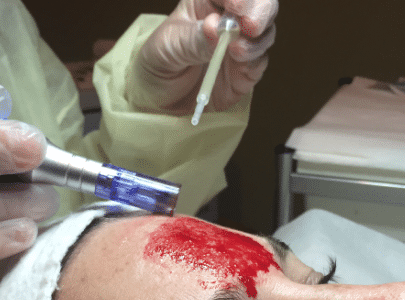Platelet Rich Plasma (PRP) Vampire Facelift is a non-surgical cosmetic treatment that is gaining popularity among those seeking a more youthful and rejuvenated appearance. In this blog, we’ll take a closer look at what PRP Vampire Facelift is, how it works, what to expect during and after the treatment, and some potential benefits and drawbacks.
What is PRP Vampire Facelift?
PRP Vampire Facelift, also known as the “vampire facial,” is a cosmetic treatment that involves injecting a patient’s own platelet-rich plasma (PRP) into the skin of the face. PRP is a solution derived from a patient’s own blood that contains a high concentration of growth factors and other healing compounds.
The procedure is called a “vampire” facelift because it involves using a device called a microneedling pen to create tiny punctures in the skin, followed by the application of PRP. The microneedling pen creates small channels in the skin, which allow the PRP solution to penetrate deep into the skin and promote healing and rejuvenation.
How Does PRP Vampire Facelift Work?
PRP Vampire Facelift works by stimulating the body’s natural healing processes. The growth factors in the PRP solution help to promote the growth of new collagen and elastin fibers, which are essential components of youthful and healthy-looking skin.
By injecting PRP into the skin, the body’s natural healing response is triggered, leading to the production of new collagen and elastin fibers. This can help to reduce the appearance of fine lines and wrinkles, improve skin texture and tone, and promote a more youthful and rejuvenated appearance.
What to Expect During and After PRP Vampire Facelift
PRP Vampire Facelift is a non-surgical procedure that is performed on an outpatient basis. The procedure takes about an hour to complete and involves the following steps:
- Blood is drawn from the patient and processed in a centrifuge to isolate the PRP solution.
- A microneedling pen is used to create tiny punctures in the skin.
- The PRP solution is applied to the skin, allowing it to penetrate deeply into the skin.
- The treatment area is cleaned and a moisturizer or sunscreen is applied.
After the treatment, patients may experience some redness, swelling, and bruising in the treatment area, which typically resolves within a few days to a week. Most patients are able to resume their normal activities immediately after the treatment.
Potential Benefits and Drawbacks of PRP Vampire Facelift
PRP Vampire Facelift offers several potential benefits, including:
- Non-surgical, minimally invasive treatment option
- Uses the patient’s own blood, reducing the risk of adverse reactions or complications
- Can improve the appearance of fine lines, wrinkles, and other signs of aging
- Can improve skin texture, tone, and overall complexion
However, there are also some potential drawbacks to consider, including:
- The cost of PRP Vampire Facelift may not be covered by insurance and can be expensive
- Some patients may experience discomfort or pain during the procedure, although this is typically mild and short-lived
- Results may vary depending on the patient’s skin type, age, and other factors
- Multiple treatments may be required to achieve the desired results, which can add to the overall cost of the treatment
Overall, PRP Vampire Facelift is a promising cosmetic treatment that can offer a more youthful and rejuvenated appearance without the need for surgery or other invasive procedures. If you are considering PRP Vampire Facelift, be sure to discuss your options with an experienced healthcare provider and weigh the potential benefits and drawbacks before making a decision.








